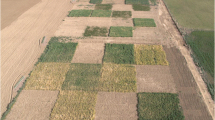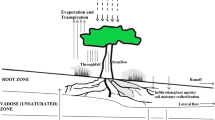Abstract
Future climate scenarios predict increases in elevated atmospheric CO2, air temperature and drought, but the impacts of multiple climate change factors on ecosystem functioning remain unclear. In this study, we compared drought responses of plants under future versus current climate conditions. In addition to focusing on stress during the drought itself, we also examined post-drought lagged effects, and whether warming and elevated CO2 alter these. We grew monocultures and mixtures of two grassland species (Lolium perenne L. and Plantago lanceolata L.) in four simulated climate scenarios: (1) current climate, (2) current climate with drought, (3) warmer temperature with drought and (4) combined warming, elevated CO2 and drought. L. perenne and P. lanceolata were influenced by the climate scenario but not differently enough to modify the competitive balance. Warming aggravated drought impacts on L. perenne and elevated CO2 only partly compensated for these effects. In a warmer climate, with or without elevated CO2, drought continued to enhance senescence and mortality in L. perenne long after the water shortage, while such lag effects were not observed in current climate. In P. lanceolata, a similar stimulation of senescence and mortality was induced, but only under combined warming and elevated CO2. These lag effects induced by the future climate may reduce resilience.







Similar content being viewed by others
References
Allen LH, Pan DY, Boote KJ, Pickering NB, Jones JW (2003) Carbon dioxide and temperature effects on evapotranspiration and water use efficiency of soybean. Agron J 95:1071–1081
Allison I, Bindoff N, Bindschadler R, Cox P, de Noblet N et al (2009) The Copenhagen diagnosis: updating the world on the latest climate science. The University of New South Wales Climate Change Research Centre (CCRC), Sydney
Anderson MJ (2001) A new method for non-parametric multivariate analysis of variance. Austral Ecol 26:32–46
Beddows AR (1967) Lolium Perenne L. J Ecol 55:567–587
Beier C, Beierkuhnlein C, Wohlgemuth T, Penuelas J, Emmett B et al (2012) Precipitation manipulation experiments—challenges and recommendations for the future. Ecol Lett 15:899–911
Benot ML, Saccone P, Pautrat E, Vicente R, Colace MP et al (2014) Stronger short-term effects of mowing than extreme summer weather on a subalpine grassland. Ecosystems 17:458–472
Benson EJ, Hartnett DC, Mann KH (2004) Belowground bud banks and meristem limitation in tallgrass prairie plant populations. Am J Bot 91:416–421
Bigler C, Gavin DG, Gunning C, Veblen TT (2007) Drought induces lagged tree mortality in a subalpine forest in the Rocky Mountains. Oikos 116:1983–1994
Chaves MM, Pereira JS, Maroco J, Rodrigues ML, Ricardo CPP et al (2002) How plants cope with water stress in the field. Photosynthesis and growth. Ann Bot 89:907–916
De Boeck HJ, Lemmens C, Zavalloni C, Gielen B, Malchair S et al (2008) Biomass production in experimental grasslands of different species richness during three years of climate warming. Biogeosciences 5:585–594
De Valpine P, Harte J (2001) Plant responses to experimental warming in a montane meadow. Ecology 82:637–648
DemmigAdams B, Adams WW (1996) The role of xanthophyll cycle carotenoids in the protection of photosynthesis. Trends Plant Sci 1:21–26
Dreesen FE, De Boeck HJ, Janssens IA, Nijs I (2014) Do successive climate extremes weaken the resistance of plant communities? An experimental study using plant assemblages. Biogeosciences 11:109–121
Dukes JS, Chiariello NR, Cleland EE, Moore LA, Shaw MR et al (2005) Responses of grassland production to single and multiple global environmental changes. PLoS Biol 3:1829–1837
Dunnett NP, Grime JP (1999) Competition as an amplifier of short-term vegetation responses to climate: an experimental test. Funct Ecol 13:388–395
Dunnett NP, Willis AJ, Hunt R, Grime JP (1998) A 38-year study of relations between weather and vegetation dynamics in road verges near Bibury, Gloucestershire. J Ecol 86:610–623
Field CB, Chapin FS, Matson PA, Mooney HA (1992) Responses of terrestrial ecosystems to the changing atmosphere—a resource-based approach. Annu Rev Ecol Syst 23:201–235
Grant K, Kreyling J, Heilmeier H, Beierkuhnlein C, Jentsch A (2014) Extreme weather events and plant plant interactions: shifts between competition and facilitation among grassland species in the face of drought and heavy rainfall. Ecol Res 29:991–1001
Hamerlynck EP, Huxman TE, Loik ME, Smith SD (2000) Effects of extreme high temperature, drought and elevated CO2 on photosynthesis of the Mojave Desert evergreen shrub, Larrea tridentata. Plant Ecol 148:183–193
IPCC (2001) Climate change 2001: the scientific basis. Contribution of Working Group I to the Third Assessment Report of the Intergovernmental Panel on Climate Change. Cambridge University Press, Cambridge, United Kingdom and New York
Jaleel CA, Manivannan P, Wahid A, Farooq M, Al-Juburi HJ et al (2009) Drought stress in plants: a review on morphological characteristics and pigments composition. Int J Agric Biol 11:100–105
Jobbagy EG, Sala OE (2000) Controls of grass and shrub aboveground production in the Patagonian steppe. Ecol Appl 10:541–549
Kongstad J, Schmidt IK, Riis-Nielsen T, Arndal MF, Mikkelsen TN et al (2012) High resilience in heathland plants to changes in temperature, drought, and CO2 in combination: results from the climate experiment. Ecosystems 15:269–283
Lauenroth WK, Sala OE (1992) Long-term forage production of north-american shortgrass steppe. Ecol Appl 2:397–403
Lichtenthaler HK, Miehe JA (1997) Fluorescence imaging as a diagnostic tool for plant stress. Trends Plant Sci 2:316–320
Littell RC, Milliken GA, Stroup WW, Wolfinger RD (1996) SAS system for mixed models. SAS institute Inc., Cary
Long SP, Humphries S, Falkowski PG (1994) Photoinhibition of photosynthesis in nature. Annu Rev Plant Physiol Plant Mol Biol 45:633–662
Morecroft MD, Masters GJ, Brown VK, Clarke IP, Taylor ME et al (2004) Changing precipitation patterns alter plant community dynamics and succession in an ex-arable grassland. Funct Ecol 18:648–655
Morgan JA, Pataki DE, Korner C, Clark H, Del Grosso SJ et al (2004) Water relations in grassland and desert ecosystems exposed to elevated atmospheric CO2. Oecologia 140:11–25
Morgan JA, LeCain DR, Pendall E, Blumenthal DM, Kimball BA et al (2011) C4 grasses prosper as carbon dioxide eliminates desiccation in warmed semi-arid grassland. Nature 476:202–206
Munne-Bosch S, Alegre L (2004) Die and let live: leaf senescence contributes to plant survival under drought stress. Funct Plant Biol 31:203–216
Naudts K, Van den Berge J, Janssens IA, Nijs I, Ceulemans R (2011) Does an extreme drought event alter the response of grassland communities to a changing climate? Environ Exp Bot 70:151–157
Naudts K, Van den Berge J, Janssens IA, Nijs I, Ceulemans R (2013) Combined effects of warming and elevated CO2 on the impact of drought in grassland species. Plant Soil 369:497–507
Niu S, Luo Y, Li D, Cao S, Xia J et al (2014) Plant growth and mortality under climatic extremes: an overview. Environ Exp Bot 98:13–19
O’Connor TG, Haines LM, Snyman HA (2001) Influence of precipitation and species composition on phytomass of a semi-arid African grassland. J Ecol 89:850–860
Porra R, Thompson W, Kriedemann P (1989) Determination of accurate extinction coefficients and simultaneous equations for assaying chlorophylls a and b extracted with four different solvents: verification of the concentration of chlorophyll standards by atomic absorption spectroscopy. Biochim Bioacta 975:384–394
Reddy AR, Chaitanya KV, Vivekanandan M (2004) Drought-induced responses of photosynthesis and antioxidant metabolism in higher plants. J Plant Physiol 161:1189–1202
Rustad LE, Campbell JL, Marion GM, Norby RJ, Mitchell MJ et al (2001) A meta-analysis of the response of soil respiration, net nitrogen mineralization, and aboveground plant growth to experimental ecosystem warming. Oecologia 126:543–562
Sagar GR, Harper JL (1964) Plantago major L., P. media L. and P. lanceolata L. J Ecol 52:189–221
Scheffer M, Carpenter S, Foley JA, Folke C, Walker B (2001) Catastrophic shifts in ecosystems. Nature 413:591–596
Schimel DS, Parton WJ (1986) Microclimatic controls of nitrogen mineralization and nitrification in shortgrass soils. Plant Soil 93:347–357
Sherry RA, Weng ES, Arnone JA, Johnson DW, Schimel DS et al (2008) Lagged effects of experimental warming and doubled precipitation on annual and seasonal aboveground biomass production in a tallgrass prairie. Glob Change Biol 14:2923–2936
Stocker TF, Qin D, Plattner G-K, Tignor M, Allen SK et al (2013) IPCC: climate change 2013: the physical science basis. Contribution of Working Group I to the Fifth Assessment Report of the Intergovernmental Panel on Climate Change. Cambridge University Press, Cambridge
Van den Berge J, Naudts K, De Boeck HJ, Ceulemans R, Nijs I (2014) Do interactions with neighbours modify the above-ground productivity response to drought? A test with two grassland species. Environ Exp Bot 105:18–24
Vinocur B, Altman A (2005) Recent advances in engineering plant tolerance to abiotic stress: achievements and limitations. Curr Opin Biotechnol 16:123–132
Walter J, Nagy L, Hein R, Rascher U, Beierkuhnlein C et al (2011) Do plants remember drought? Hints towards a drought-memory in grasses. Environ Exp Bot 71:34–40
Wardle DA, Peltzer DA (2003) Interspecific interactions and biomass allocation among grassland plant species. Oikos 100:497–506
Weeve T (1975) Flora Neerlandica. Koninklijke Botanische Vereniging, Amsterdam
Wiegand T, Snyman HA, Kellner K, Paruelo JM (2004) Do grasslands have a memory: modeling phytomass production of a semiarid South African grassland. Ecosystems 7:243–258
Wu ZT, Dijkstra P, Koch GW, Penuelas J, Hungate BA (2011) Responses of terrestrial ecosystems to temperature and precipitation change: a meta-analysis of experimental manipulation. Glob Change Biol 17:927–942
Zavaleta ES, Thomas BD, Chiariello NR, Asner GP, Shaw MR et al (2003) Plants reverse warming effect on ecosystem water balance. Proc Natl Acad Sci USA 100:9892–9893
Zavalloni C, Gielen B, Lemmens CMHM, Boeck HJ, Blasi S et al (2008) Does a warmer climate with frequent mild water shortages protect grassland communities against a prolonged drought? Plant Soil 308:119–130
Acknowledgments
H. Van De Velde is a Research Assistant of the Fund for Scientific Research-Flanders (FWO). We thank N. Calluy and M. Wellens for technical assistance, K. Naudts and J. Van den Berge for field assistance.
Author information
Authors and Affiliations
Corresponding author
Additional information
Communicated by Erik P. Hamerlynck.
Electronic supplementary material
Below is the link to the electronic supplementary material.
Rights and permissions
About this article
Cite this article
Van De Velde, H., Bonte, D., AbdElgawad, H. et al. Combined elevated CO2 and climate warming induces lagged effects of drought in Lolium perenne and Plantago lanceolata . Plant Ecol 216, 1047–1059 (2015). https://doi.org/10.1007/s11258-015-0488-2
Received:
Accepted:
Published:
Issue Date:
DOI: https://doi.org/10.1007/s11258-015-0488-2




